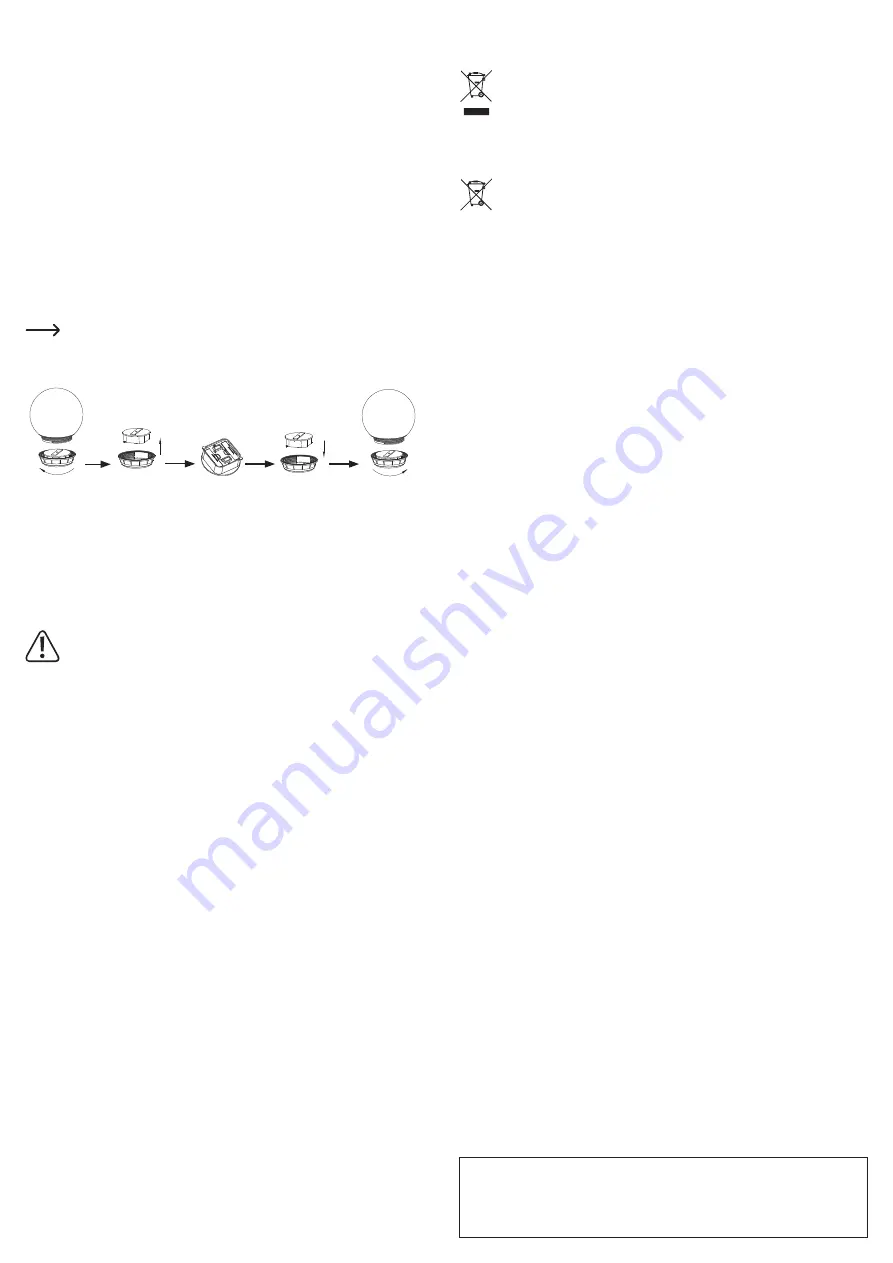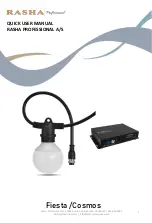
These operating instructions are published by CEI Conrad Electronic International (HK) Limited, 18th Floor, Tower 2,
Nina Tower, No. 8 Yeung Uk Road, Tsuen Wan, New Territories, Hong Kong. All rights including translation reserved.
Reproduction by any method (e.g. photocopying, microfilming, or the capture in electronic data processing systems)
requires prior written approval from the editor. Reprinting, also in part, is prohibited. The operating instructions reflect the
current technical specifications at time of print.
Copyright 2018 by CEI Conrad Electronic International (HK) Limited
*1646407_v1_0218_02_hk_m_en
Important notes
• The power of the solar panel varies according to the time of year and depends on the duration
and strength of the sunlight. During prolonged periods without sufficient sunlight (especially
in winter), the batteries may not charge enough to power the light for a sustained period of
time. During the day the batteries are recharged with less energy than they consume at night.
Thus, the lighting duration is inevitably reduced. In such circumstances, the batteries may
completely discharge, which can damage the batteries. Therefore, remove the batteries from
the product in due time.
•
Keep the lamp head clean. Dust and dirt reduce the efficiency of the solar panel, causing the
charging current for the rechargeable batteries to decrease.
• Cold temperatures have a negative impact on the battery life (the light stays on for a shorter
period at night). To prolong the lifespan of the product, store it in a dry, warm room during the
winter (or when you are not going to use it for an extended period). To do this, remove the
batteries from the product.
• You can charge the batteries using a suitable battery charger before placing them into the
product. Observe the instructions in this manual when removing/replacing the rechargeable
batteries.
Removing/replacing the rechargeable batteries
Replace the batteries as soon as the light duration is significantly reduced, even
though the batteries were sufficiently charged during the day.
Ensure that no liquids get into the lamp head when changing the battery.
Observe the illustrations when changing the batteries.
• Remove the base cover by unscrewing it counter clockwise from the lamp head. The seal on
the lamp head should not be removed.
• Remove the solar unit from the base cover. The rechargeable battery compartment is located
on the back side.
• Remove the rechargeable battery compartment covers. Remove the rechargeable batteries
and replace them with identical rechargeable batteries (see technical data). Pay attention to
correct polarity (+/-). Close the rechargeable battery compartment covers.
Never use disposable non-rechargeable batteries.
• Place the solar unit back in the base cover.
• Screw the base cover with the solar unit clockwise into the lamp head. Make sure that the
base cover screws in smoothly and the seal is not crushed.
Care and Cleaning
• Never use aggressive cleaning agents or chemical solutions as the surface of the product
could be damaged (discolouration).
• Further, do not point water jets (e.g. from a high-pressure cleaner) at the light, since this could
damage the gaskets.
• The product does not require maintenance except for occasional cleaning.
•
Allow the product to cool down sufficiently before cleaning.
• Use a clean, soft and dry cloth to clean the product. To remove stubborn dirt, moisten the
cloth slightly with lukewarm water.
• Do not press too hard on the product as this can lead to scratch marks.
Disposal
a) Product
Electronic devices are recyclable waste and must not be disposed of in the
household waste. Always dispose of the product according to the relevant statutory
regulations.
Remove the rechargeable batteries and disposed of them separately from the
product.
b) Batteries
You are required by law to return all used batteries (Battery Directive). Batteries
must not be placed in household waste.
Batteries containing hazardous substances are labelled with this symbol to indicate
that disposal in household waste is forbidden. The abbreviations for heavy metals
in batteries are: Cd = Cadmium, Hg = Mercury, Pb = Lead (indicated on the battery,
e.g. below the trash icon on the left).
Used batteries can be returned to local collection points, our stores or battery retailers.
You thus fulfil your statutory obligations and contribute to the protection of the environment.
Technical data
Power supply ................................ 2 x 1.2 V, 600 mAh NiMH rechargeable battery (AAA)
Power consumption ...................... max. 0.14 W
Illuminant ...................................... 2 x LEDs
Luminous flux
............................... 7 lm
Light colour ................................... 2600 K (warm-white)
LED life ......................................... 20 000 h
Light ON time ................................ approx. 6 - 8 hours on a fully charged battery
Protection type .............................. IP44
Operating/storage conditions ........ -20 to +40 °C, 0 – 100 % RH
Dimensions (Ø x H) ...................... 150 x 307 mm (with ground spike)
Weight .......................................... approx. 337 g (with batteries and ground spike)
Distributed by Conrad Electronic SE, Klaus-Conrad-Str. 1, D-92240 Hirschau


























